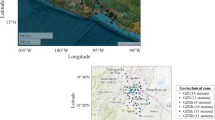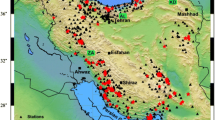Abstract
This paper addresses new prediction models for computing the number of equivalent cycles in liquefaction analyses. Three models are presented for the Italian seismicity as a function of synthetic ground motion parameters that are often available from earthquake data web-sites immediately after events. In particular, it is observed that the number of earthquake cycles can be best estimated from the five following parameters: peak ground acceleration; epicentral distance; Arias Intensity; the mean period; and, the frequency of zero crossings. However, strong estimations can be obtained from the first three parameters only. We use statistical indicators to determine the goodness of the models and the usefulness of the selected independent variables, and we present a comparative analysis to validate our predictive equations. Moreover, this paper describes the existing correlation between magnitude and cycle numbers. The study is primarily based on Italian acceleration records, even if the database is also expanded to recorded European, Japanese and American events to amplify the magnitude values range. These simplified models are useful in addressing practical earthquake engineering problems which require the knowledge of number of equivalent cycles.













Similar content being viewed by others
References
Ambraseys NN (1988) Engineering seismology. Earthq Eng Struct Dyn 17:1–105
Andrus RD, Stokoe KH (1997) Liquefaction resistance based on shear wave velocity. In: Proceeding of the NCEER workshop on evaluation of liquefaction resistance of soils. Buffalo, N.Y, U.S. National Center for Earthquake Engineering Research (NCEER), Technical Report NCEER, 97-0022
Arango I (1996) Magnitude scaling factors for soil liquefaction evaluations. J Geotech Eng 122(11):929–936
ASTM (1985) Cycle counting in fatigue analysis. Annual Book of ASTM Standards 1985, Vol. 03.01, E1049-85
Benasciutti D (2004) Fatigue Analysis of Random Loadings. Ph.D. Thesis at University of Ferrara, Italy, Dept. of Engineering
Biondi G (2002) Instabilità sismica dei pendii sabbiosi causata da incrementi di pressione interstiziale. Ph.D. Thesis in Geotechnical Engineering, Università di Catania, Italy (in Italian)
Biondi G, Cascone E, Maugeri M (2004) Number of uniform stress cycles equivalent to seismic loading. In: 11th Conference on soil dynamics and earthquake engineering, 3th conference on earthquake geotechnical engineering, University of California, Berkeley, 2004
Biondi G, Cascone E, Di Filippo G (2012) Affidabilità di alcune correlazioni empiriche per la stima del numero di cicli di carico equivalente. Rivista Italiana di Geotecnica 2(2012):11–41 (in Italian)
Bland JM, Altman DG (1996) Statistics notes: measurement error. BMJ 313:744
Boulanger RW, Idriss IM (2015) Magnitude scaling factors in liquefaction triggering procedures. Soil Dyn Earthq Eng 79:296–303
De Alba P, Seed HB, Chan CK (1976) Sand liquefaction in large-scale simple shear test. J Geotech Eng Div 102(9):909–927
Di Filippo G, Biondi G, Cascone E (2013) Nuovi modelli previsionali per la valutazione del numero di cicli di carico equivalente. Incontro Annuale dei Ricercatori di Geotecnica 2013- IARG 2013 Perugia
Goldberg DE (1989) Genetic algorithms in search. Optimization and Machine Learning, Wesley, p 1989
Green RA (2001) Energy-based evaluation and remediation of liquefiable soils. Ph.D. Dissertation, Virginia Polytechnic Institute and State University
Haldar A, Tang WH (1981) Statistical study on uniform cycles in earthquake. J Geotech Eng Div ASCE CVII(5):577–589
Hancock J, Bommer JJ (2004) Predicting the number of cycles of ground motion. In: 13th World conference on earthquake engineering, Paper No. 1989, Vancouver
Holland JH (1975). Adaptation in Natural and Artificial Systems. Ph.D. Thesis, University of Michigan Press, Ann Arbor
Idriss IM (1999) An update to the Seed-Idriss simplified procedure for evaluating liquefaction potential. In: Proceedings TRB workshop on new approaches to liquefaction., Publication No. FHWA-RD-99-165, Federal Highway Adm
Italian Technical Code (2008) CS.LL.PP., Norme tecniche per le costruzioni, G.U.R.I. 29, DM 14 Gennaio 2008 (in Italian)
Lasley SJ, Green RA, Rodriguez-Marek A (2017) Number of equivalent stress cycles for liquefaction evaluations in active tectonic and stable continental regimes. J Geotech Geoenviron Eng. https://doi.org/10.1061/(ASCE)GT.1943-5606.0001629
Liu AH, Stewart JP, Abrahamson NA, Moriwaki Y (2001) Equivalent number of uniform stress cycle for soil liquefaction analysis. J Geotech Geoenviron Eng 127(12):1017–1026
Luzi L, Pacor F, Puglia R (2016) Italian Accelerometric Archive v 2.1. Istituto Nazionale di Geofisica e Vulcanologia, Dipartimento della Protezione Civile Nazionale. https://doi.org/10.13127/itaca/2.1
Miner MA (1945) Cumulative damage in fatigue. Trans ASME 67:A159–A164
Palmgren A (1924) Die lebensdauer von kugella geru. ZVDI LXVIII(14):339–341
Santucci de Magistris F (2015) The occurrence of liquefaction at low acceleration level. In: 6th ICEGE, Christchurch, New Zealand
Seed HB (1968) Landslides during earthquake due to soil liquefaction. Fourth Terzaghi Lecture. J Soil Mech Found Div ASCE XCIV(5):1053–1122
Seed HB, Idriss IM (1967) Analysis of soil liquefaction: Niigata earthquake. J Soil Mech Found Div ASCE XCIII(3):83–108
Seed HB, Idriss IM (1971) Simplified procedure for evaluating soil liquefaction potential ASCE. J Geotech Eng Div XCVII(9):339–363
Seed HB, Idriss IM (1982) Ground motions and soil liquefaction during earthquakes. Earthq Eng Res Inst, Berkeley
Seed HB, Idriss IM, Makdisi F, Banerjee N (1975) Representation of irregular stress time histories by equivalent uniform stress series in liquefaction analysis. Report EERC 75-29, University of California
Valera JE, Donovan NC (1977) Soil liquefaction procedures—A review. J Geotech Eng ASCE CIII(6):607–625
Yoshimi Y, Tokimatsu K, Kaneko O, Makinara Y (1984) Undrained cyclic shear strength of dense Niigata sand. Soils Found XXIV(4):131–145
Youd TL, Noble SK (1997) Liquefaction criteria based on statistical and probabilistic analyses. In: Proceeding of the NCEER workshop on evaluation of liquefaction resistance of soils. Buffalo, N.Y, U.S. National center for earthquake engineering research (NCEER), Technical Report NCEER, 97-0022
Youd TL, Idriss IM, Andrus RD, Arango I, Castro G, Christian JT, Dobry R, Finn WDL, Harder LF Jr, Hynes ME, Ishihara K, Koester JP, Liao SSC, Marcuson WF III, Martin GR, Mitchell JK, Moriwaki Y, Power MS, Robertson PK, Seed RB, Stokoe KH II (2001) Liquefaction resistance of soils: summary report from the 1996 NCEER and 1998 NCEER/NSF workshops on evaluation of liquefaction resistance of soils. J Geotech Geoenviron Eng ASCE 127–10:817–833
Acknowledgements
This research was partially carried out under the framework of the ReLUIS-DPC 2014–2018 project. The authors wish to thank Drs. Salvatore Gerbino and Carmine Cerrone of the University of Molise and Dr. Fatemeh Jalayer of the University of Naples Federico II for fruitful discussions and for assisting with our analysis of the data.
Author information
Authors and Affiliations
Corresponding author
Electronic supplementary material
Below is the link to the electronic supplementary material.
Appendices
Appendix A
This appendix illustrates an example of the computation the equivalent number of cycles following Seed et al.’s (1975) procedure.
Referring to the HNE horizontal acceleration recording for 1.5 to 5 s of the Atina ATQ station, at the epicentral distance of 17.42 km, for the Lazio-Abruzzo earthquake (Italy) of May 11, 1984, with a moment magnitude of 5.5 (Luzi et al. 2016), a simplified example of the complete procedure is shown in Fig. 14 and Table 10 applying the following steps:
-
1.
The recorded accelerogram is normalized on its peak value amax;
-
2.
Peaks of the signals are identified via the peak counting method, using a threshold value of 0.15 (red dots in Fig. 14 and accelerograms peaks columns in Table 10) and for each one the absolute value of the a/amax ratio is extracted (|a/amax| column in Table 10);
-
3.
The liquefaction resistance curve is selected; in this specific example, Liu et al.’s (2001) curve is used. It is defined by the range between the direct simple shear curves DSS+ and DSS-. An arithmetic average is generated between the values of their parameters as reported by Biondi et al. (2004) and then R = 0.65 and m = 0.344 (Fig. 1). By adding the graph of the liquefaction resistance curve with each peak ratio a/amax to the ordinate axis, it is possible to obtain the number of cycles from the horizontal one (Neq column of Table 10);
-
4.
The total number of cycles is obtained by summing the values of each peak (the last value shown under the Neq column in Table 10).
Appendix B
This appendix illustrates an example of computation of the equivalent number of cycles, following the Rainflow Counting Method.
The Rainflow Counting Method is schematized in Fig. 15, where the cascade logical procedure for cycles counting is outlined following the ASTM Standards (1985). Several parameters introduced in Fig. 15 (peaks, valleys and range) are clarified in Fig. 16.
Rainflow counting method (Hancock and Bommer 2004)
From a physical point of view, it identifies hysteresis stress cycles of the material response (the soil response in this specific case) with the maximum cycle identified from maximum and minimum efforts of the stress and strain sequences (peaks A and D in stress and strain histories of Fig. 16, corresponding to points A and D of the hysteresis loop). Therefore, any temporal history can be thought to be composed of a main loop from the absolute minimum value to the absolute maximum value or vice versa (points A and D in Fig. 17), interrupted by several inversions forming secondary cycles (B–C, E–F and G–H in Fig. 17). The application of a time dependent acceleration load to a soil deposit leads to the development of stress and strain histories that are responsible of damage induced by the irregular load in the ground. Consequently, Rainflow Counting is particularly useful in assessing cycles counting for time history input data (Benasciutti 2004). The hysteresis loop describes energy dissipated in the soil for the entire duration of earthquake motion. Some quantities are sketched in the stress–strain plan shown in Fig. 18, where W is the maximum amount of energy stored in elastic material with the same shear modulus G as the visco-elastic one and where ΔW1 is energy dissipated per unit of material volume in one loading cycle. In referring to dissipated energy, the number of equivalent cycles can be computed from the ratio between the energy dissipated per unit of volume during earthquake motion, ΔW, and ΔW1 as indicated in Eq. 15. The ΔW1 contribution can be easily expressed as 2πDτγ where D is the damping ratio, τ is shear stress and γ is shear strain. This equation explains the relationship between the number of equivalent cycles and the material hysteresis loops for energy-type equivalence approaches. Further issues related to this topic are elaborated in Green (2001).
Hysteresis loop quantities (Green 2001)
As done for the previous approach (cf. “Appendix A”), an example of the Rainflow Counting Method is shown in Fig. 19, where the computed cycles and half cycles are identified for the same portion of the accelerometric recording (i.e., HNE horizontal acceleration recording between 1.5 and 5 s for the ATQ station for the Lazio-Abruzzo earthquake). Relative information on the extracted cycles is reported in Table 11 in terms of amplitudes (ai), means, numbers (NRc), extraction start times and cycle periods. The example shows the final equivalent cycle number obtained from Hancock and Bommer’s (2004) procedure, summarized in the last column of the table for the i-th half cycle with the total number shown in the last row (NeqHB).
It is worth noting that in this specific example, the number of cycles derived from Seed et al.’s (1975) method (6.43) is slightly lower than the number obtained using Hancock and Bommer’s (2004) procedure (8.28).
Rights and permissions
About this article
Cite this article
Castiglia, M., Santucci de Magistris, F. Prediction of the number of equivalent cycles for earthquake motion. Bull Earthquake Eng 16, 3571–3603 (2018). https://doi.org/10.1007/s10518-018-0336-6
Received:
Accepted:
Published:
Issue Date:
DOI: https://doi.org/10.1007/s10518-018-0336-6










